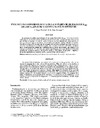Identificador persistente para citar o vincular este elemento:
https://accedacris.ulpgc.es/handle/10553/9343
| Campo DC | Valor | idioma |
|---|---|---|
| dc.contributor.author | Yepes Temino, J. | en_US |
| dc.contributor.author | Vidal Romaní, J. R. | en_US |
| dc.date.accessioned | 2013-01-31T06:00:05Z | |
| dc.date.accessioned | 2018-03-15T14:30:00Z | - |
| dc.date.available | 2013-01-31T06:00:05Z | |
| dc.date.available | 2018-03-15T14:30:00Z | - |
| dc.date.issued | 2002 | en_US |
| dc.identifier.issn | 0367-0449 | en_US |
| dc.identifier.uri | https://accedacris.ulpgc.es/handle/10553/9343 | - |
| dc.description.abstract | Se presenta el análisis morfológico de un sector del replano RIOOO' El sector escogido\nestá colgado por encima de la red fluvial actual. Este hecho permite atribuir a los cursos\nque drenan el replano un carácter semi funcional. Se han identificado once niveles de\nterrazas erosivas, que corresponden al desmantelamiento del replano inicial. La geometría\nde la red permite suponer que la organización actual se alcanzó mediante sucesivas\ncapturas. Por otra parte, se han distinguido dos trazados de la red (centrípeta y en bayoneta);\nla red centrípeta define una superficie hueca y la red en bayoneta una superficie en\nrampas escalonadas. Se propone que ambas morfologías corresponderían a diferentes\nestadios de un mismo proceso: el vaciado del RIOOO' Por último, se propone la hipótesis\nde un descabalamiento tectónico del Rgoo para el origen de los Llanos. | en_US |
| dc.description.abstract | We present the morphological analysis of a sector of the R IOOO replane. The sector\nchosen is hanging above the current fluvial network. This fact allows us to attribute a\nsemi-functional character to the courses which drain the replane. Eleven levels of erosive\nterraces have been identified, which correspond to the degradation of the initial replane.\nThe geometry of the network allows us to suppose that the current organisation was reached\nby means of successive captures. On the other hand, two layouts of the network\nhave been distinguished (centripetal and in bayonet). The centripetal network defines a\nhollow surface and the bayonet network a surface in stepped inclines. We propose that\nboth morphologies correspond to different stages of a same process: the hollowing out of\nthe RIOOO' Lastly we propose the hypothesis of a tectonic pattem of the Rgoo for the origin\nof the Llanos. | en_US |
| dc.format | application/pdf | es |
| dc.language | spa | en_US |
| dc.relation.ispartof | Estudios Geologicos | en_US |
| dc.rights | by-nc-nd | es |
| dc.source | Estudios Geologicos [ISSN 0367-0449], v. 58, p. 179-188 | en_US |
| dc.subject | 250607 Geomorfología | en_US |
| dc.subject.other | Geomorphology of Galician Massif | en_US |
| dc.subject.other | Fluvial net evolution | en_US |
| dc.subject.other | Neotectonic | en_US |
| dc.title | Evolución geomorfológica de la superficie de erosión R1000 en los Llanos de Castro Caldelas (Ourense) | en_US |
| dc.title.alternative | Geomorphological evolution of the R1000 erosion surface in Level One of the Castro Caldelas (Ourense) | en_US |
| dc.type | info:eu-repo/semantics/article | en_US |
| dc.type | Article | en_US |
| dc.identifier.scopus | 1642355243 | - |
| dc.contributor.authorscopusid | 16314521900 | - |
| dc.contributor.authorscopusid | 7006641648 | - |
| dc.identifier.absysnet | 625445 | - |
| dc.description.lastpage | 188 | en_US |
| dc.description.firstpage | 179 | en_US |
| dc.relation.volume | 58 | en_US |
| dc.investigacion | Ingeniería y Arquitectura | en_US |
| dc.rights.accessrights | info:eu-repo/semantics/openAccess | en_US |
| dc.type2 | Artículo | en_US |
| dc.utils.revision | Sí | en_US |
| dc.identifier.ulpgc | Sí | en_US |
| dc.description.scie | SCIE | |
| item.fulltext | Con texto completo | - |
| item.grantfulltext | open | - |
| crisitem.author.dept | GIR IOCAG: Geología Aplicada y Regional | - |
| crisitem.author.dept | IU de Oceanografía y Cambio Global | - |
| crisitem.author.dept | Departamento de Ingeniería Civil | - |
| crisitem.author.orcid | 0000-0001-5039-1482 | - |
| crisitem.author.parentorg | IU de Oceanografía y Cambio Global | - |
| crisitem.author.fullName | Yepes Temiño, Jorge | - |
| Colección: | Artículos | |
Visitas
57
actualizado el 27-ene-2024
Descargas
35
actualizado el 27-ene-2024
Google ScholarTM
Verifica
Comparte
Exporta metadatos
Los elementos en ULPGC accedaCRIS están protegidos por derechos de autor con todos los derechos reservados, a menos que se indique lo contrario.
